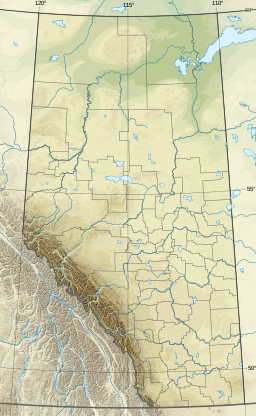
Back بحيره ليسير سلاڤ ARZ Малко Робско езеро Bulgarian Malo ropsko jezero BS Llac Lesser Slave Catalan Lesser Slave Lake CEB Malé Otročí jezero Czech Кĕçĕн Ирĕксĕрлĕ кӳлĕ CV Kleiner Sklavensee German Malgranda Slavia Lago Esperanto Pequeño Lago de los Esclavos Spanish
| Lesser Slave Lake | |
|---|---|
 Southeast corner of the lake from Marten Mountain looking south, with Dog Island, Devonshire Beach, and the Town of Slave Lake visible in the distance | |
| Location | Big Lakes / Lesser Slave River No. 124, Alberta |
| Coordinates | 55°26′26″N 115°29′19″W / 55.44056°N 115.48861°W |
| Type | Eutrophic[1] |
| Primary inflows | South Heart River, Swan River Driftpile River, Assineau River, Marten River |
| Primary outflows | Lesser Slave River |
| Catchment area | 13,900 km2 (5,400 sq mi)[2] |
| Basin countries | Canada |
| Max. length | +100 km (62 mi) |
| Max. width | 15 km (9.3 mi) |
| Surface area | 1,168 km2 (451 sq mi)[3] |
| Average depth | 11.4 m (37 ft) |
| Max. depth | 20.5 m (67 ft) |
| Water volume | 13.69 km3 (11.10×106 acre⋅ft)[2] |
| Shore length1 | 247 km (153 mi) |
| Surface elevation | 578 m (1,896 ft) |
| Settlements | Slave Lake, High Prairie, Alberta |
| References | [1][2][3] |
| 1 Shore length is not a well-defined measure. | |
Lesser Slave Lake is located in northern Alberta, Canada, northwest of Edmonton. It is the second largest lake entirely within Alberta boundaries (and the largest easily accessible by vehicle), covering 1,160 km2 (450 sq mi) and measuring over 100 km (62 mi) long and 15 km (9.3 mi) at its widest point. Lesser Slave Lake averages 11.4 m (37 ft) in depth and is 20.5 m (67 ft) at its deepest. It drains eastwards into the Athabasca River by way of the Lesser Slave River.
The town of Slave Lake is located at the eastern tip of the lake, around the outflow of Lesser Slave River.
- ^ a b Atlas of Alberta Lakes. "Lesser Slave Lake". Archived from the original on 2011-07-19. Retrieved 2007-05-01.
- ^ a b c International Lake Environment Committee. "Lesser Slave Lake". Archived from the original on 2007-07-13. Retrieved 2007-05-01.
- ^ a b Atlas of Canada. "Lakes of Canada". Archived from the original on April 10, 2007. Retrieved 2007-05-01.
